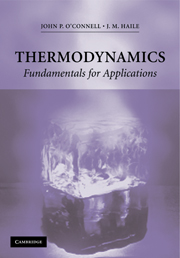Book contents
- Frontmatter
- Contents
- Preface
- Acknowledgments
- THERMODYNAMICS: Fundamental for Applications
- 0 Introduction
- PART I THE BASICS
- PART II SINGLE-PHASE SYSTEMS
- PART III MULTIPHASE AND REACTING SYSTEMS
- PART IV ENGINEERING CALCULATIONS
- 10 Options for Equilibrium Calculations
- 11 Elementary Computational Procedures
- 12 Selected Applications
- AFTERWORD
- APPENDICES
- Notation
- Index
10 - Options for Equilibrium Calculations
Published online by Cambridge University Press: 05 June 2012
- Frontmatter
- Contents
- Preface
- Acknowledgments
- THERMODYNAMICS: Fundamental for Applications
- 0 Introduction
- PART I THE BASICS
- PART II SINGLE-PHASE SYSTEMS
- PART III MULTIPHASE AND REACTING SYSTEMS
- PART IV ENGINEERING CALCULATIONS
- 10 Options for Equilibrium Calculations
- 11 Elementary Computational Procedures
- 12 Selected Applications
- AFTERWORD
- APPENDICES
- Notation
- Index
Summary
In previous parts of this book we have developed rigorous, generalized, thermodynamic descriptions of phenomena. With this chapter we begin to convert those descriptions into specific forms that can be applied to phase and reaction equilibrium calculations. Such calculations always requires us to make decisions—to select from among alternative computational strategies. For example, a common decision to be faced is this: Which of the five famous fugacity formulae should I use? If, in a given situation, our models are all reliable and their parameters are all known, and if we can solve all appropriate thermodynamic relations, then our choices are relatively simple: our decisions are dictated by the process, the substances involved, and their states. Unfortunately, most situations are not so simple: we usually have limited information about the process, all necessary properties of the substances may not be known, some models may be of limited reliability, and rigorous computational routes may be inaccessible. Such constraints complicate the selection process, forcing us to balance thermodynamic rigor, model reliability, and computational simplicity.
In § 10.1 we present the basic thermodynamic relations that are used to start phase-equilibrium calculations: we discuss vapor-liquid, liquid-liquid, and liquid-solid calculations. We have seen that the most interesting phase behavior occurs in nonideal solutions, but when we describe nonidealities using an ideal solution as a basis, we must select an appropriate standard state. Common options for standard states are discussed in § 10.2; they include pure-component standard states and dilute-solution standard states.
- Type
- Chapter
- Information
- ThermodynamicsFundamentals for Applications, pp. 420 - 476Publisher: Cambridge University PressPrint publication year: 2005



